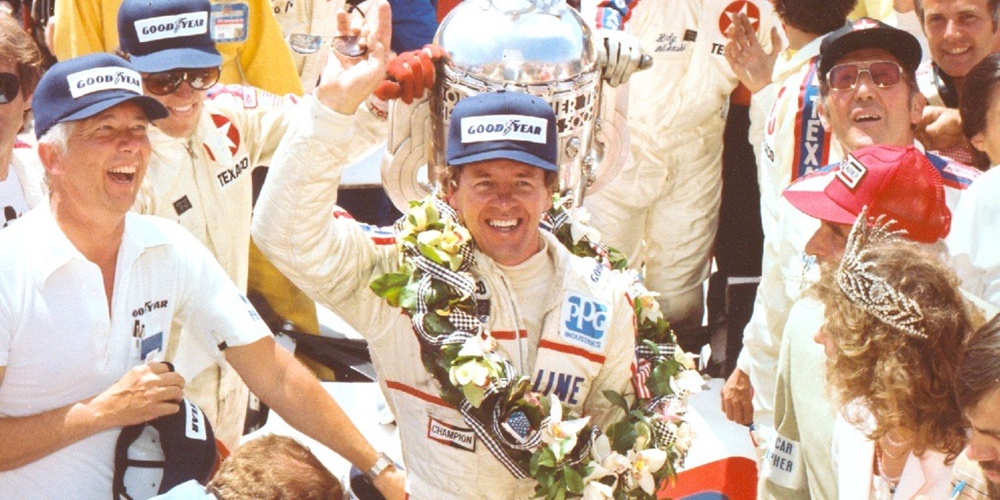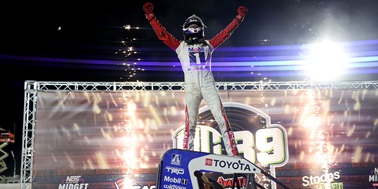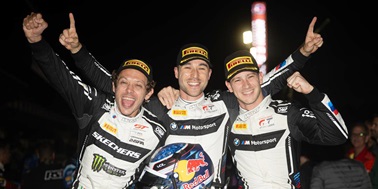Forty years ago, Tom Sneva was the most famous bridesmaid in Indianapolis 500 history.
Sneva, a former schoolteacher from Spokane, Washington, was Indy’s first 200-mph man, and he finished second in the race in 1977, ’78 and ’80. But victory in the world’s biggest race eluded “The Gas Man” until 1983, and he had to overcome the first father-and-son duo in the long history of the Indianapolis Motor Speedway to make the dream come true.
Remarkably, Sneva entered the 67th running of the Indianapolis 500 believing it was his least likely chance of winning in his 10-year Indy career to that point. Even without a win, his record at the Brickyard was stellar; Sneva topped 200 mph during qualifying in 1977, and he backed it up with the first four-lap qualifying average of above 200 mph a year later. But second-place finishes in the ’77 and ’78 “500s,” along with USAC-sanctioned Indy car championships the same years, were not enough to keep his seat at Penske Racing. He bounced between lesser teams for the next three years.
“Tom drove for us for a number of years, won the championship and was a tremendous qualifier,” team owner Roger Penske said. “Every time I saw him come off of Turn 4, I thought he would never get the thing turned. He drove it right on the edge and he was good for the team, but he and I had some different ideas on how we wanted to go. He was a smart guy and one of the key drivers that brought us to the next level.”
Sneva’s prospects improved when he landed a ride with newly formed Bignotti-Cotter Racing prior to the 1981 season. Co-owned by legendary chief mechanic George Bignotti, the team was one of the first to adopt the ground-effect March chassis that subsequently dominated the mid-80s.
Yet the month of May 1983 was anything but smooth for Sneva and Bignotti.
“We were having all kinds of engine reliability problems, and actually, leading up to the race, we hadn’t had a motor that could run 100 miles,” Sneva said. “So we had a little bit of unrest in the team, and I thought that would be my least likely chance, up to that point, to win the race.”
Still, a fresh Cosworth engine installed for Carb Day and the race proved to be the magic bullet. After starting on the inside of the second row, Sneva found himself in a competitive car on Race Day. Rookie Teo Fabi took pole position (the first time since 1950 that a first-year driver started from the Indy pole) and led the first 23 laps of the race, but the Italian’s race lasted just 47 laps before a crew error caused damage to his car’s fuel tank. Second-year driver Bobby Rahal also led twice for 15 laps before being sidelined by a broken radiator in his March-Cosworth.
That left the race to be contested between Sneva and Al Unser, who combined to lead the final 126 laps. Sneva held the upper hand, but when the duo made their final pit stops under yellow on Lap 173, Penske Racing got Unser out in the lead, saving time by not changing tires on his Penske-Cosworth.
When action was set to resume with 24 laps to go, Sneva was right behind Unser as the cars circulated behind the Pace Car. But just before the green flag was waved, 21-year old rookie Al Unser Jr., who was five laps down after making no fewer than 11 pit stops, jumped the restart and darted past a number of cars under yellow to position himself between his father and Sneva.
When racing resumed with 60 miles to go, Unser led with Sneva second. But Sneva was unable to pass Unser Jr.’s lapped car as the rookie cannily adopted an obtrusive line around the track. While Al Jr. repeatedly refused to heed blue “move over” flags, Sneva was forced to bide his time and stay patient.
Unser Jr. freely admitted he was trying to keep Sneva behind him to protect his father in the lead.
“Sure, I saw the flag guy, but I wasn’t going to move over,” Unser Jr. said. “TV came up with the word ‘blocking.’ I was just trying to keep him second, to make it a little bit harder for him to pass. My dad told me if he was in my shoes, he would have done the exact same thing.”
Added the elder Unser: “What Al did was not illegal in any way. We all know what blocking is, and we all know how to do it. He didn’t do it.”
With the laps ticking down, Sneva collected himself and planned a late-race attack.
“One of the things a driver has to do is check their emotions in certain situations,” Sneva said. “If you let things creep up on you, it’s going to affect how you drive the car and probably have an adverse effect on the outcome. It was hard to check all those emotions when you’re running out of laps in the Indy 500. But we were able to do that for the few laps when we needed to.”
Sneva finally got his chance with 10 laps to go as the leading duo came upon the slower car driven by Dick Simon. Trapping Unser Jr. behind Simon, Sneva pulled alongside on the main straight and made a clean pass on the inside at Turn 1. He had gotten such a massive run that he caught the elder Unser by Turn 2 and easily took the race lead by the time the cars reached Turn 3.
From there, Sneva had an uncontested run to the biggest payday of his career. He pulled out a four-second gap over Unser within a lap, and he romped away to win by 11.174 seconds. His winning average speed of 162.117 mph was then the second fastest in the history of the race. It was the first of five consecutive Indianapolis 500 wins for March, and the seventh and final Indy victory for Bignotti.
After the race, the main talking point was Unser’s perceived blocking tactics.
“I doubt the circumstances would ever be exactly the same again, but I would do the exact same thing,” Junior said. “I wasn’t just some spoiled rich kid trying to help out his dad, being illegal and dangerous. The only thing Tom said to me afterward was, ‘We sure put on a great show for the folks.’ He wasn’t angry at all. Once he decided to go by me, bang! He knew all along he could do it. It was just a matter of when.”
Sneva never complained about the Unser family tag-team effort.
“When you’re in Victory Circle, you’re able to be diplomatic about some of the competition that was providing some of the resistance,” he said with a laugh.
Remarkably, Sneva never finished the “500” again in eight additional starts, though he added another pole in 1984. But history won’t forget that he is an Indianapolis 500 winner. It’s an honor he remains intensely proud of to this day.
“You didn’t realize it at the time, but it’s a tag that stays with your name for the rest of your life,” Sneva said. “It tends to open up a lot of doors, and you get a lot of opportunities because of that. It’s the single race that you want to win the most.”




